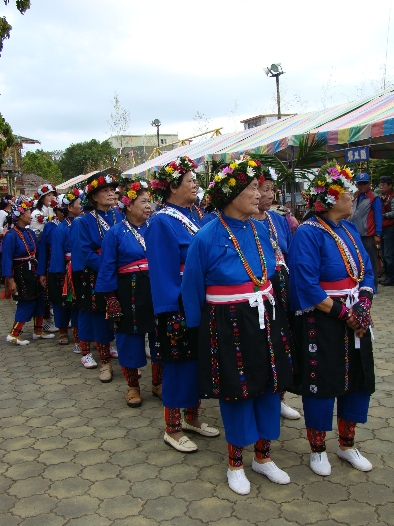Highlights of the Puyuma Mugamut: one of the few remaining women's ceremonies
Of Taiwan’s 14 officially recognized tribes, three traditionally possessed matrilineal societies (the Amis, Kavalan and Puyuma tribes). However, there are very few examples remaining of women’s ceremonies among these tribes. This makes the Mugamut of the Puyuma tribe extremely important. Mugamut is the Puyuma term for the Women’s Completion of Weeding Work Celebration.
In Taiwan’s matrilineal societies, the women were in charge of all matters of the household, including the gathering and preparation of food, growing of millet, rearing of children and making of beautifully embroidered clothing for special ceremonies. To celebrate women and to pass on the traditions of the tribe, Nanwang Village in Taitung County has been working to revive the Mugamut.
In the past, the Puyuma population was smaller than it is now and as millet was a staple grain of the tribe the millet fields were larger. Thus, the women formed weeding groups, called misaur in the Puyuma language, to help one another complete the back breaking work of eliminating weeds that would otherwise choke the millet stalks impeding their growth.
Misaur were composed of adult women for the two months of work during the weeding season from February to the middle of April. To celebrate the completion of the weeding work, the Mugamut was usually held in mid-March. In recent years, to make organization more convenient, the Mugamut has consistently taken place on the second weekend in March.
Although millet has decreased in importance among Taiwan’s indigenous tribes, traditions related to the millet season should not be forgotten. Thus, the women of Nanwang maintain a small millet field to demonstrate the weeding process.
The day before the Mugamut, they dress in colorful skirts and work shirts and hats and meet early in the morning at the home of the eldest woman of the group that is responsible for organizing the Mugamut that year. From there, they march together to the field, chanting the entire way in the Puyuma language. This helps to pass the time during the 40-minute walk.
Once they have arrived at the field, the women immediately start working to clear the weeds. Some of the weeds look very much like millet stalks and it takes a trained eye to distinguish the difference. Some of the older women sing traditional ballads as they work. Young boys from the village carry long bamboo tubes filled with water, and bring them to each of the women to let them drink, which is how they kept hydrated while working in Taiwan’s warm spring climate.
After the weeding is finished, it is time to walk back to the village, again in formation and chanting. The women stop along the way at a bush filled with bright pink blossoms. They pick the blossoms and excitedly place them in their hats, knowing that this makes them all the more beautiful.
In the afternoon, they meet outside the Palakuwan. The Palakuwan is the village’s youth meeting hall. This is where the young, unmarried males of the tribe receive training in fighting and hunting skills, as well as learn the oral history of the tribe. Women are not allowed inside the Palakuwan but can participate in activities on the plaza outside.
A priestess or female shaman and her assistant prepare betel nuts, splitting them open and stringing three beads through them. Each betel nut represents the spirit of a person who has died over the past one year. They place the betel nuts on a long machete-like knife and turn it three times in a clockwise direction while chanting a spell. The knife is thought to cut away evil. There is then another walk for about 20 minutes through part of the village to a place where rattan vines grow and where it is said that the ancestral spirits dwell. The priestess speaks a few words to the vines and chooses one to cut down. It is then unfurled on the ground. The women line up on both sides over the entire length of the vine. They pick it up and carry it together to the village. This signifies unity between the deceased ancestors and the living, as well as among the women carrying the vine. It is thought that by honoring the ancestral spirits that the Mugamut will be successful.
The next morning, the activities of the Mugamut begin. The women dress in their formal ceremonial attire including characteristic flower wreath. They line up in pairs according to age outside the Palakuwan. The oldest women are in front with the youngest in the back. The color of their clothing differs according to age, from blue to white to black. Some of the women carry a hunting knife at their side. This is unusual as such knives are an essential accessory for the males of the tribe, as they were used for hunting and fighting. However, during the Mugamut, the women with a husband or son who owned such a knife would borrow it. As no men were allowed to join the Mugamut, this meant that the women would have to defend themselves if they were attacked. The women parade along the streets surrounding the Palukuwan. They then participate in foot races. After that, it is back to the Palakuwan for dancing and singing, some traditional and some contemporary.
Much of the meaning of this event may be lost to outsiders, but its true spirit is to encourage camaraderie among the women of the village as they help each other to fulfill all of their important roles in society. It is also a type of women’s day out, a chance to have fun and relax after the hard work of cultivating the fields. It is hoped that as modern life continues to encroach on tribal traditions that the meaning of the Mugamut will be preserved.






